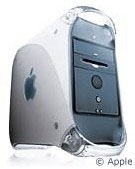Remember when laptop computers were so expensive and underpowered
that a desktop was the best thing you could buy?
Up until recently this was the case with me. My best machine was
always my desktop, and a laptop was just an extra toy to take to school
to play an occasional Age of Empires round.
Today my PowerBook is my main machine, capable of doing anything I
need with room to expand its horizons if needed. My desktops have
become backup servers, Solaris/Linux leaning tools, and media center
computers for watching movies and playing games.
The trend towards portable power is progressing with no signs of
slowing down. However, people like me still have a need for a desktop
from time to time - but not for everyday computing.
Apple offers only three desktop machines; the Mac mini, the iMac, and the Power Mac (to be replaced by an
Intel-based counterpart later this year).
The mini is nice for the average consumer, but it lacks the
expandability that I crave, while the Power Mac is just too expensive.
A midrange system, the iMac, is very capable, but also lacks expansion
slots like the mini.
 I needed something capable of
running the iLife '06 suite as well as Final Cut (in the near future),
graphic software, FTP server, remote access server, and with room for a
SCSI RAID array, but I didn't want to shell out another $2,000 for
something way more powerful than I needed. So I decided to look to
yesteryear's Macs for a solution.
I needed something capable of
running the iLife '06 suite as well as Final Cut (in the near future),
graphic software, FTP server, remote access server, and with room for a
SCSI RAID array, but I didn't want to shell out another $2,000 for
something way more powerful than I needed. So I decided to look to
yesteryear's Macs for a solution.
The Power Mac G4
Gigabit Ethernet was the first commercially available PC with
built-in 10/100/1000 (gigabit) ethernet, and it sports the beautiful G4
case design. I managed to snag one for under $200 with minimal hardware
specs: 400 MHz G4, 128 MB RAM, 10 GB hard drive, DVD-RAM drive (useless
in today's world, unfortunately), and a built in Zip 100 drive.
My reasons for choosing this system were simple:
- CPU expandability - For a moderate $150-400 I can easily upgrade the CPU to speeds up
1.8 GHz with dual processors
- Cheap memory - I was able to reuse RAM I had laying around the
house, maxing it out at 2 GB.
- PCI and AGP expandability - There are tons of options available for
expandability (video, sound, SCSI, USB 2.0, etc.)
- Case space - The case can accommodate up to six internal hard
drives with appropriate mounting brackets and power supplies. I've
installed an 80 GB boot drive, a secondary 120 GB internal drive, and
an external 200 GB USB 2.0 drive.
An important note about this model: The IDE controller does not
support 48-bit addressing, meaning that drives over 128 GB aren't
supported (see How Big a Hard Drive Can
I Put in My iMac, eMac, Power Mac, PowerBook, or iBook?). The system may detect a
larger drive, but once the initial 128 GB is filled, you may
experience anomalies.
There are three ways of getting around this: Find the elusive third
party utility that allows for 48-bit addressing in these models,
purchase a PCI IDE controller that supports 48-bit addressing, or set
up a SCSI hard drive, since SCSI has no 128 GB barrier.
The advantage of the PCI Cards (IDE and SCSI) is that you can gain a
speed boost if you purchase an ATA100 or 133 card or a SCSI160
setup.
Needless to say, Tiger runs smooth with 2 GB of RAM, the only
glitches coming in when using Dashboard with the underpowered 16 MB ATI
Rage video card in this Power Mac. iMovie and iPhoto also run
relatively well considering the six-year-old hardware it's running
on.
Final Cut Express is an issue, however, since it requires more than
a 400 MHz G4 (Apple lists 500 MHz as the minimum). However, this can be
fixed in time with the above-mentioned CPU upgrade.
FTP services haven't been tested as of yet, but I don't foresee any
issues, and thanks to an external 200 GB USB 2.0 hard drive, backing up
my precious iTunes library from my PowerBook is very easy.
At a total cost of less then $300, this system is a perfect
companion to my trusty PowerBook, and it cost far less than a Mac mini.
It also has the potential of being more powerful when necessary.
How much Mac do your really need?


 I needed something capable of
running the iLife '06 suite as well as Final Cut (in the near future),
graphic software, FTP server, remote access server, and with room for a
SCSI RAID array, but I didn't want to shell out another $2,000 for
something way more powerful than I needed. So I decided to look to
yesteryear's Macs for a solution.
I needed something capable of
running the iLife '06 suite as well as Final Cut (in the near future),
graphic software, FTP server, remote access server, and with room for a
SCSI RAID array, but I didn't want to shell out another $2,000 for
something way more powerful than I needed. So I decided to look to
yesteryear's Macs for a solution.
